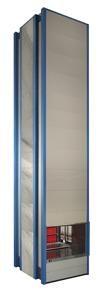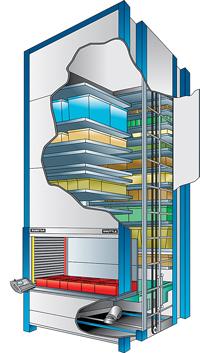- FMA
- The Fabricator
- FABTECH
- Canadian Metalworking
Categories
- Additive Manufacturing
- Aluminum Welding
- Arc Welding
- Assembly and Joining
- Automation and Robotics
- Bending and Forming
- Consumables
- Cutting and Weld Prep
- Electric Vehicles
- En Español
- Finishing
- Hydroforming
- Laser Cutting
- Laser Welding
- Machining
- Manufacturing Software
- Materials Handling
- Metals/Materials
- Oxyfuel Cutting
- Plasma Cutting
- Power Tools
- Punching and Other Holemaking
- Roll Forming
- Safety
- Sawing
- Shearing
- Shop Management
- Testing and Measuring
- Tube and Pipe Fabrication
- Tube and Pipe Production
- Waterjet Cutting
Industry Directory
Webcasts
Podcasts
FAB 40
Advertise
Subscribe
Account Login
Search
5 ways to leaner die handling
Vertical storage and retrieval systems help shops reach for lean
- By Ed Romaine
- August 8, 2007
- Article
- Materials Handling
Conventional rack, shelving, and drawer systems used in many stamping facilities are a less-than-lean method of storing dies. They consume a lot of floor space, and locating and retrieving dies encroaches on production time. In addition, these conventional methods expose dies to damage.
The focus of lean manufacturing initiatives is to eliminate waste that occurs during manufacturing operations and to optimize process flow to improve overall efficiency. Vertical automated storage and retrieval systems address five lean manufacturing goals for stamping die storage options: maximizing space utilization, increasing employee productivity, ensuring safety, optimizing equipment efficiency, and reducing tooling costs.
How Vertical Systems Address Five Lean Goals
- By Saving Floor Space. One of the ways a vertical storage and retrieval system helps meet lean manufacturing initiatives is by improving space utilization because they use otherwise unoccupied vertical space (see Figure 1). Depending on the usable building interior heights, up to 85 percent of a conventional storage system's occupied floor space can be recovered.
- By Reducing Redundant Handling. Vertical systems help reduce redundant or nonessential handling, especially in applications requiring frequent reuse of stamping dies.
- By Reducing Tooling Costs. Die damage caused by frequent handling can interrupt process flow. Because vertical storage and retrieval systems are enclosed and lockable, they protect stored items from external hazards and reduce product damage. Likewise, vertical systems can integrate software controls that can restrict and track die usage to specific individuals, departments, or shifts.
- By Improving Safety. The access area of vertical systems is ergonomically designed to present stored items at an ideal height for picking, usually about waist-high (see lead image). This reduces unnecessary or excess motion and contributes to employee safety, because this ergonomic positioning design eliminates the bending, climbing, and stretching associated with conventional shelving and rack systems.
- By Increasing Equipment Uptime. Another key lean goal is reduction of wait time. Conventional static storage systems require employees to spend up to 70 percent of their time traveling aisles searching for items, while only 30 percent is spent actually retrieving items. Vertical storage and retrieval systems allow quick access to stored items via a system of rotating carrier shelves or delivered trays that bring the exact storage position to the operator (see Figure 2). Typically, a vertical system reverses that 70/30 percent ratio.
Recovered floor space can be re-allocated from cost-associated inventory functions to value-increasing production operations. Improved space utilization also can extend the useful life of existing facilities, eliminating the need for expensive brick and mortar expansion to meet growth requirements.
The small unit footprint makes vertical systems especially valuable for point-of-use storage. Storing dies and other tooling at point-of-use reduces unnecessary processing and transportation common with central storage.
The systems can be configured to store various sizes of items, from dies to tooling to fasteners to safety products, and can be easily reconfigured to accommodate physical changes in stored items, such as finished goods. This will allow shops to keep on hand only what they need.
Vertical storage and retrieval systems can be equipped with microprocessor controls, position indicators, information displays, and PC-based software to further increase the speed at which specific tooling is located and retrieved in the system.
Controlling System Operation
Vertical storage and retrieval systems can be controlled using PC software or hardware controls. A system can be configured for stand-alone, single-user operation or a multiuser network. The operator enters the shelf number using the controls, and the shelf and its contents are delivered automatically.
For functional effectiveness, transaction information must be communicated between the operator and the control system. The level of the system's sophistication will help determine how the information will be displayed to the operator.
For example, in a strictly manual system, the operator decides all location transactions and enters the shelf or tray locations via keypad. This activity is followed by manual inventory adjustments.
In a fully automated environment, all information requests—from location selection, container type, inventory adjustment, activity analysis, and data—transfers between the vertical system's software and the facility's host system, such as a shop's MRP system. This can be accomplished transparently, with no operator intervention.
Selecting the Right System
Because they help shops meet the requirements for lean manufacturing, vertical storage and retrieval systems can have a verifiable positive return in terms of improved operating efficiency if they are properly configured for specific applications.
However, as with any major investment, a comparison of the costs of a new system versus the old system must be considered. Sitting down with an installation specialist and putting the numbers into a standard return on investment/internal rate of return (ROI / IRR) formula is one way to do this. Another way is to use an ROI/IRR calculator that allows users to enter the appropriate data that automatically computes the daily costs of the current system and the new system. The calculator also computes dollar savings from reduced space requirements, cost savings from improved employee productivity, depreciation savings, and total annualized savings. From this information, the shop can determine the payback schedule for a specific installation.
Is a Vertical Storage and Retrieval System Right for Your Shop?
Because vertical systems can be configured with many shelf and tray variations, load data is used to design the application to the need. For the storage of stamping dies, weight is a primary consideration. To define system requirements, you must calculate average weight density to determine shelf or tray loading capacity. Once load data has been determined and grouped by size and weight, it can be used to determine optimum vertical spacing, depth, and width.
Consideration also must be given to the physical layout of the installation site. The clear height of the building interior will determine the height of the units and the total number of shelves or trays allowed in each unit. It is possible to estimate space savings in square feet and percentages using general formulas developed by automated storage and retrieval system manufacturers (see Figures 3 and 4).
For example, in a facility with a ceiling height of 40 feet, a vertical storage and retrieval system can eliminate up to 100 shelving sections with a resulting space savings of up to 929 square feet, or 91 percent. For a ceiling height of 30 ft., a vertical system can eliminate 46 drawer-type cabinets for a space savings of 311 sq. ft., or 80 percent.
Industrial buildings with at least 4 to 6 in. of reinforced concrete over a solid, compacted base will support most loaded vertical systems.
About the Author
Ed Romaine
41 Eisenhower Drive
Westbrook, ME 04092
908-537-7201
Related Companies
subscribe now

The Fabricator is North America's leading magazine for the metal forming and fabricating industry. The magazine delivers the news, technical articles, and case histories that enable fabricators to do their jobs more efficiently. The Fabricator has served the industry since 1970.
start your free subscription- Stay connected from anywhere

Easily access valuable industry resources now with full access to the digital edition of The Fabricator.

Easily access valuable industry resources now with full access to the digital edition of The Welder.

Easily access valuable industry resources now with full access to the digital edition of The Tube and Pipe Journal.
- Podcasting
- Podcast:
- The Fabricator Podcast
- Published:
- 04/16/2024
- Running Time:
- 63:29
In this episode of The Fabricator Podcast, Caleb Chamberlain, co-founder and CEO of OSH Cut, discusses his company’s...
- Industry Events
16th Annual Safety Conference
- April 30 - May 1, 2024
- Elgin,
Pipe and Tube Conference
- May 21 - 22, 2024
- Omaha, NE
World-Class Roll Forming Workshop
- June 5 - 6, 2024
- Louisville, KY
Advanced Laser Application Workshop
- June 25 - 27, 2024
- Novi, MI


































